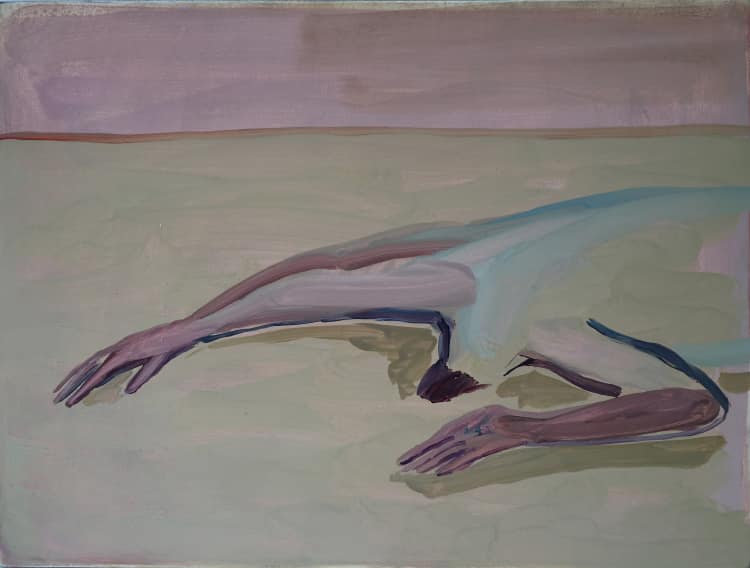Eve Ackroyd’s Paintings Of Male Nudes Flip The Script On Woman-As-Muse
The Brooklyn-via-Brixton artist is participating in a new exhibition at Chelsea’s Kent Fine Art gallery.

On a sticky evening last summer, I caught the subway up to Harlem to see a wall of penises. The penises belonged to a series of nude men painted by London artist Eve Ackroyd, and they were on display in an apartment-turned-ad hoc gallery called Chapter 61. The men lacked heads but Ackroyd’s thick brushstrokes gifted them with a delightfully playful sense of personality — a welcome reprieve from the usual bravado associated with depictions of masculinity. Aren’t bodies fun?, they seemed to say.
Ackroyd, who has made bodies the focus of her work during the decade since she graduated art college, certainly thinks so. Yet she rarely paints whole bodies, instead focusing on bits of them: flocks of tiny hands, lips pursed in pissed-off scowls, androgynous-looking heads with their eyes closed. To Ackroyd, the body and its composite parts form an endlessly shifting psychological landscape through which to explore the fragmented self. That’s something that has taken on deeper meaning for the 32-year-old artist since she and her young family made the move from Brixton, South London to a leafy part of Brooklyn three years ago.
This month, Ackroyd is exhibiting a new collection of paintings that scrabble at the subconscious as part of a group show called On Painting at Chelsea’s Kent Fine Art gallery. I went along on opening night to talk embracing limitations, flipping the script on the archetypal woman-as-muse, and involving her kids in her work.
Bodies are hugely important to your work, and specifically nude bodies. Yet rather than being presented for a sexualized gaze, the paintings seem to be about the subjects' relationships with themselves. These figures...
...are alone. They're always in moments of being alone. I've always been interested in presenting the body in these moments of isolation. Although there are [sometimes] configurations of figures in the work, I often feel like that could be one person exploring a gesture or [their] different selves. I don't think of the figures as characters. They're never people to me; they're expressions of feelings. It's a huge mix of external things going on and then me processing those thoughts and trying to make them exciting, beautiful, playful.
They're always naked because I really don't want to place them in any sort of context; they're never within rooms. Over the last three or four years, the figures have always been in these scapes of color — muddy brushstrokes of hazy surroundings — to put them in psychological landscapes where they can really be considered. I want people when they're looking at my work to consider these bodies, or these heads, as emotional, sentient beings. So I think that's the reason I haven't clothed them. I want there to be this universal feeling where, although [what inspired them is] deeply personal, the themes in there are something everyone can understand.
“We use our bodies as a kind of frontier, battling all these millions of things everyday.”
Often for artists who identify as women, their work is forced to be about women. Yet your male figures are often more impactful. It’s exciting to see presentations of masculinity without a socially constructed public face.
We use our bodies as a kind of frontier, battling all these millions of things everyday. I wanted these images of the body — male and female — at rest [to explore] this huge mix of emotions. [With the male figures,] I don't want it to be seen as a "well, I'll strip you down" thing — I mean, maybe it is slightly antagonistic in a way because you see so many male artists unclothe women without any need or responsibility to explain. There's hundreds of thousands of years of that, and artists still get away with it so much, and it's not questioned at all. I think mine's done in a much more gentle manner — being able to see these men as these vulnerable beings.
As a woman, you're not allowed to talk about vulnerability without being personal. Although I can't say "I" with my paintings, I think a female body will be viewed as being personal. [But] it’s okay to take those personal feelings and look at them objectively, and be able to intellectually play with that and dissect it without it being so personal.
Do you paint from memory?
I used to seek photographs and use a lot of film stills and collage those, but over the last few years I haven't at all. I've made drawings from photographs of films, very rough ones, but then I've been painting directly from drawings, or freehand. And I think that has brought [my work] into this much more psychological realm, much more playful. It's brought a stronger sense of my own body making the work, maybe using it as a tool — looking at my own body to take a line or something.
When did the hands start coming in?
Years and years ago. There's always a little hand creeping or clasping. It was definitely a tactic to jolt. I wanted to bring in something from the external world to disturb. I always feel like they're not real — they're drawn, translucent like crayons — and they never quite touch the body, even when the fingers are rounded. I think it's exploring being aware of yourself always being viewed or your relationships with others, and the weight of [that]. Some of them could be children's hands, probably to do with never quite having your body as your own after [having kids]. I definitely think of them as drawings onto the paintings, rather than real. But they just keep coming back! Sometimes they're arms now.
How has moving from London to New York shaped your work?
In London, things happened sort of naturally — I went to art school, I met my group of friends, and then I found a studio, and it just fell into place in that way. Moving [to New York], I didn't really know artists and, in a great way, it made me able to consider how I worked before, and how I want to work now, and how I want to present myself.
I'm working from home — and so many artists I know here work from home — so that was a challenge. My work downsized but I'm going with that, and I'm kind of exploring how I can really push that intimacy within the work.
How does your work today embrace space limitations?
Aside from the scale — I've got to have something I can easily move at the end of the day — it's the actual fact of working from home and that being a domestic space. Rather than battling against that — God, I'd love to be alone and close the door and not have to have people walking past the studio or my kids in there all the time — instead just going with it and embracing all the possibilities that that brings about. In the last two or three years since I moved, I can really see that tension in the work. Rather than thinking about it negatively, I can see these little conversations between the small paintings, and I think they've got it. They do have anxiety but they have humor; I can't be that uptight about them because people are always walking past the studio, always seeing work half-done.
What do your kids understand of your work?
They’re much more interested in their own art, which is good. And they should be, it's amazing. I steal ideas from them. I've been going in to do a few days at [my son] Marv's school, here and there, helping with art. Kids are all incredible at drawing. It's all there and I don't know when we lose it. There's no hierarchy of putting images onto paper — cat heads float alongside the word "fart" and then there's a building; they're so wild. I'm stealing ideas from that, trying to free up.
For a show in Oakland that I did called Precious, I got two big muslin pieces about 16 feet long, and I just cleared our sitting room and invited the kids to make the work with me. I said, "It's about bodies, draw any bits of bodies." So, of course, a bum and willy were the first things. I said to Marv, "You can't do bottoms." And he said, “Well, you always put them in your work!" They loved that show — they came to the opening, we had a great time. The next three months of no school, there'll be more collaborative pieces.




